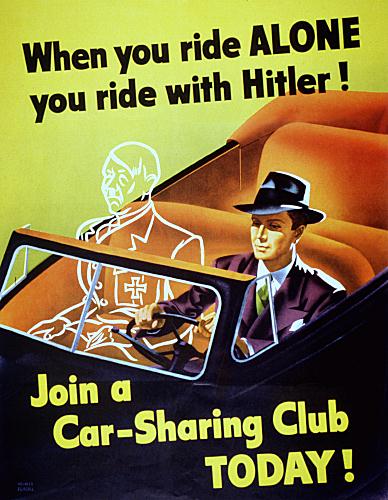Fordlandia

Before World War II, most automobile tires were made from natural rubber — latex collected from rubber trees. But by 1942, the United States found itself in a bind. Japan had taken control of Asia, which happened to be where the most abundant amount of readily-available rubber trees were. And the war effort required rubber. To counter this, the U.S. took a multi-pronged approach. First, it ramped up research into synthetic rubber (which not only proved ultimately successful, but has become the main source for rubber in tires). Second, the government pushed citizens to donate used tires in hopes of recycling them — a failed idea as recycling rubber is something we still can’t do. And finally, the government instituted gasoline rations and pushed pro-carpooling propaganda, as seen above, all in an effort to reduce driving and, therefore, rubber use. Reducing gasoline use was not nearly as important — in fact, synthetic rubber is made from petroleum.
But all of this may have been averted — or at least limited — had Henry Ford been able to better execute on an idea: a town in Brazil focused on cultivating rubber trees.
While most rubber tree plantations are now in South and Southeast Asia — as they were in World War II — the rubber tree is actually indigenous to the Amazon rainforest and specifically, Brazil. Nevertheless, by 1928, commercial cultivation of rubber had already moved to Malaysia, and the Ford Motor Company was dependant on rubber from there (then a British colony), and Mr. Ford saw this reliance as a threat to his company. To counteract this, he set up a prefabricated industrialized town called Fordlandia, located in the middle of the rainforest. (Here is a map.)
The premise was simple — grow rubber trees where they were supposed to be grown — but the execution doomed the project. The trees were planted closely together much like they were in Malay plantations, but this alignment proved disastrous in the rainforest ecosystem, as natural predators feasted on the trees. The terrain — hilly and rocky — wasn’t conducive to planting the trees in the first place. Even human resources issues were mismanaged, as employees from local villages were expected to Americanize. Instead, at one point in 1930, they revolted, and management literally fled into the jungles. (The Brazilian Army ended up being called in to quell the rebellion.)
The promise of rubber trees unfulfilled, Fordlandia managed to putter along for another decade and a half — failing to live up to its promise the whole time. With synthetic rubber well established by 1945, Ford sold Fordlandia at a $20 million loss, according to mental_floss. Today, the town is abandoned and left in ruins.
Bonus Fact: Fordlandia was a failure, but the Dearborn Inn was a success. The inn (Wikipedia entry here) was also the brainchild of Henry Ford. Mr. Ford realized that when visitors came to the Detroit area via Ford Airport in Dearborn, Michigan, they did so without a place to stay — so Mr. Ford had the inn constructed to fix that. The Dearborn Inn is considered to be the world’s first airport hotel.
From the Archives: Turkey and Chickens: Why Ford intentionally destroys parts of some of its own vehicles.
Related: “Fordlandia: The Rise and Fall of Henry Ford’s Forgotten Jungle City” by Greg Grandin. Four stars on 71 reviews.

Leave a comment